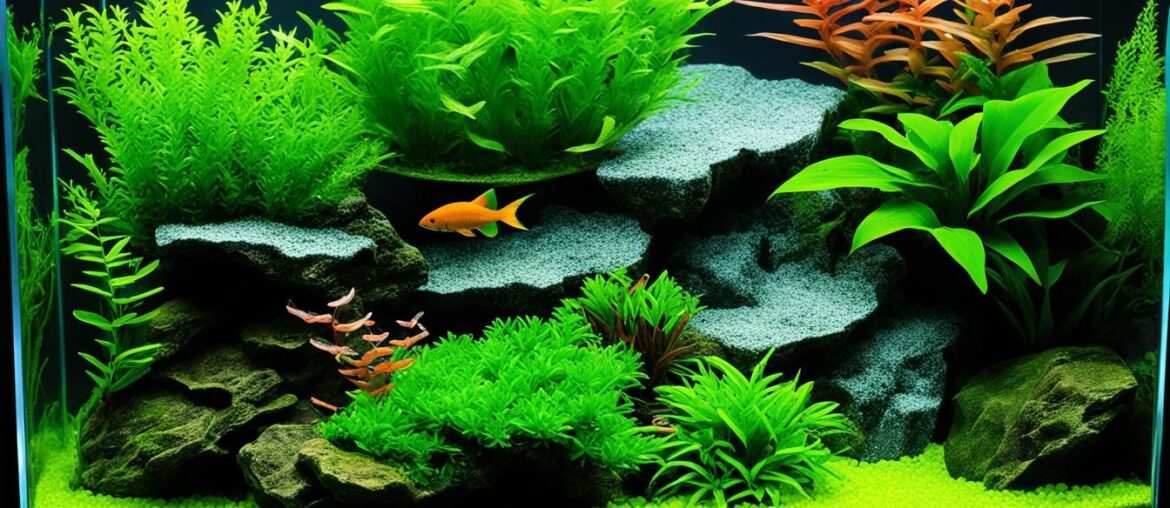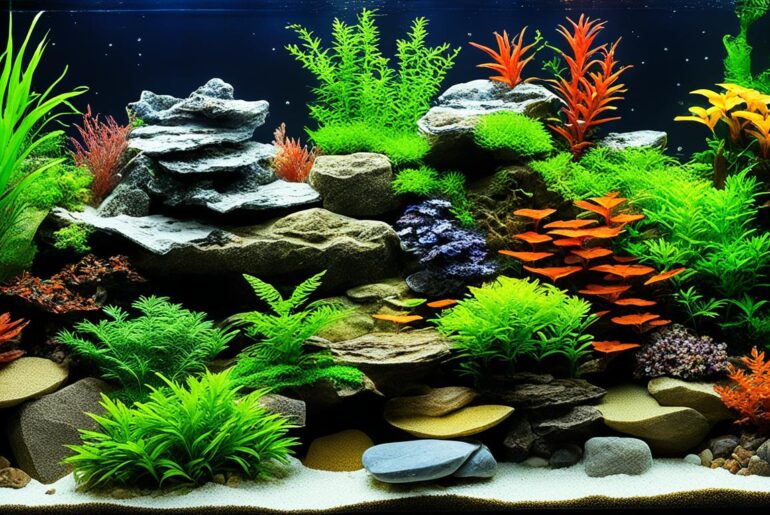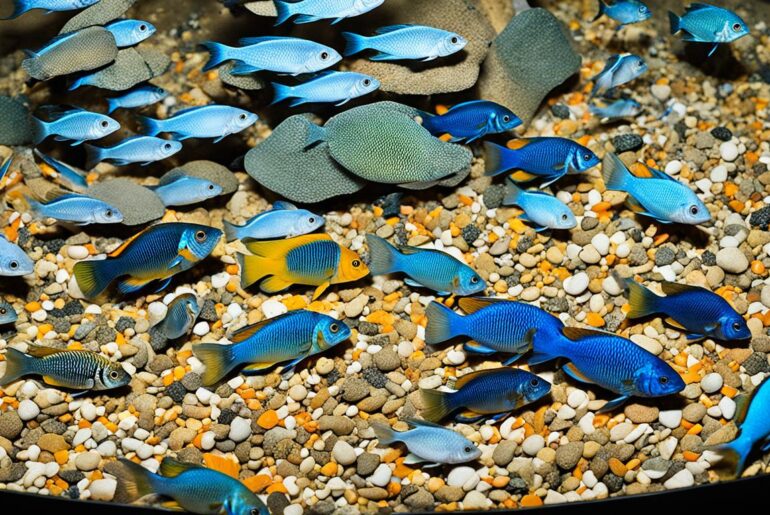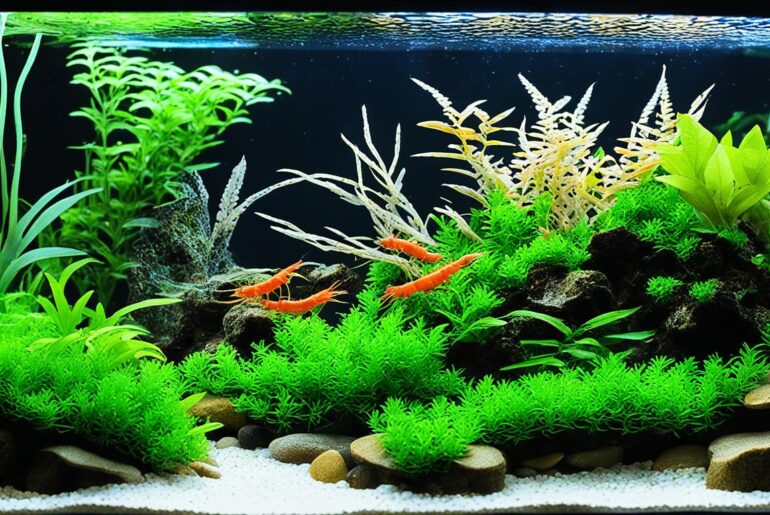Have you ever stared into a freshwater aquarium and felt a sense of wonder? The vibrant colors, the graceful movements of the fish, the lush greenery of the plants – it’s like a mesmerizing underwater world right in your own home. I, too, have experienced this profound connection with my aquarium.
When I first started my journey as an aquarium enthusiast, I realized that choosing the right substrate for my freshwater tank was crucial. It’s not just about aesthetics; the substrate plays a vital role in creating a suitable environment for your fish and plants.
In my quest for the best, I delved into the world of freshwater aquarium substrates and discovered a multitude of options. From natural-looking gravel to vibrant sands, from nutrient-rich soil to colorful marbles – the choices seemed endless. With each substrate offering its unique benefits, I became determined to find the best color substrate that would enhance the beauty of my aquatic haven.
As I embarked on this journey, I learned about the importance of considering the preferences of my fish and plants. I discovered that different substrates cater to the diverse needs of various aquatic species. Whether you have a tank full of lively fish or a lush planted aquarium, there is a perfect substrate out there for you.
Join me on this exploration of the best color substrates for freshwater aquariums. Discover the options that will not only make your tank visually stunning but also provide a thriving environment for your aquatic companions. Let’s dive in!
Key Takeaways:
- Choosing the right substrate is crucial for creating a suitable environment in your freshwater aquarium.
- Consider the preferences of your fish and plants before selecting a substrate.
- Options include gravel, sand, soil, aragonite, vermiculite, peat moss, coral, marbles, and layering substrates.
- Each substrate offers unique benefits and aesthetics, enhancing the beauty of your aquarium.
- Take your time to explore and experiment, finding the perfect color substrate for your freshwater tank.
Gravel
Gravel is a highly versatile substrate choice for freshwater aquariums, offering numerous benefits for both fish and aquarium enthusiasts. Its popularity stems from its alluring aesthetics and easy maintenance, making it a popular choice among hobbyists.
One of the major advantages of using gravel as a substrate is the wide range of colors and particle sizes available. With various options to choose from, you can create a customized and visually appealing look for your aquarium. Whether you prefer a natural and earthy tone or a vibrant and colorful substrate, gravel provides the flexibility to suit your preferences.
Another significant benefit of gravel as a substrate is its ease of cleaning. Uneaten food and fish waste can be effortlessly removed with a gravel vacuum, ensuring a clean and healthy environment for your aquatic pets. Regular cleaning prevents the buildup of harmful toxins, helping to maintain optimal water quality.
When selecting gravel for your aquarium, it’s crucial to choose varieties with smooth edges. This is particularly important for fish with delicate skin, such as catfish, as rough gravel can lead to irritation and injuries. So, keep their well-being in mind while choosing the gravel for your tank.
Types of Gravel for Aquariums
Gravel comes in various types, each with its own unique characteristics. Here are some popular options:
- Standard Gravel: This type of gravel is readily available and commonly used in freshwater tanks. It usually features rounded edges and is suitable for a wide range of fish species.
- Colored Gravel: If you’re looking to add a pop of color to your aquarium, colored gravel is a fantastic choice. It comes in a variety of vibrant shades, allowing you to create a visually striking tank.
- Substrate Coated Gravel: Substrate coated gravel consists of small pebbles coated with a layer of nutrients, promoting plant growth in planted tanks.
How to Clean Gravel Substrate
Cleaning gravel substrate is a simple process that helps maintain a healthy environment for your aquarium inhabitants. Here’s a step-by-step guide:
- Prepare a siphon vacuum or a gravel vacuum specifically designed for aquarium use.
- Insert the vacuum into the gravel, allowing it to reach the bottom of the tank.
- Gently move the vacuum around, creating a suction that pulls up any debris, uneaten food, and fish waste from the gravel.
- Continue vacuuming until you’ve cleaned the desired area, ensuring not to remove too much water in the process.
- Regularly clean and empty the vacuum to prevent the debris from reentering the tank.
By following these simple steps, you can easily maintain the cleanliness and overall health of your aquarium.
Sand
When it comes to selecting the perfect substrate for your freshwater aquarium, sand offers numerous benefits. Not only does sand closely replicate the natural environment of many aquarium fish, but it also provides a soft and smooth surface that is ideal for bottom-dwelling species.
One of the key advantages of using sand as a substrate is its ease of maintenance. Unlike other substrates, sand does not trap uneaten food or waste, making it effortless to keep your aquarium clean and pristine. A simple siphon or gravel vacuum can effectively remove any debris from the sand bed, promoting a healthier environment for your fish and plants.
Sand comes in a variety of grain sizes and colors, allowing you to create visually captivating effects in your aquarium. From fine white sand that resembles a tranquil beach to coarser and darker sands that mimic the bed of a river, the options are virtually endless. You can choose a sand substrate that complements the overall theme and aesthetic of your tank, creating a captivating underwater landscape.
Types of Sand for Aquariums
The availability of different types of sand for aquariums allows you to experiment and tailor your substrate to suit your needs. Here are a few popular options:
- River sand: This type of sand typically has a coarser texture and is commonly used for river-themed aquarium setups.
- Play sand: Play sand is fine-grained and often used for creating a natural-looking beach-like environment in your tank.
- Aragonite sand: Aragonite sand is rich in calcium carbonate and is preferred by enthusiasts who desire a substrate that can positively influence pH levels in their aquarium.
To determine the best sand type for your aquarium, consider the needs and preferences of your fish and plants. Some species may thrive better with a certain grain size or color of sand.
How to Clean Sand Substrate
Cleaning sand substrate is a straightforward process that helps maintain water quality in your aquarium. Here’s a simple step-by-step guide:
- Use a gravel vacuum or siphon to remove any debris and waste from the sand bed.
- Insert the vacuum into the sand, making gentle back-and-forth motions to disturb any trapped particles.
- Allow the waste to flow into a bucket or sink, ensuring it is properly disposed of.
Regular maintenance, such as weekly or bi-weekly cleaning, will help prevent the buildup of harmful substances and ensure a healthy environment for your aquatic pets.
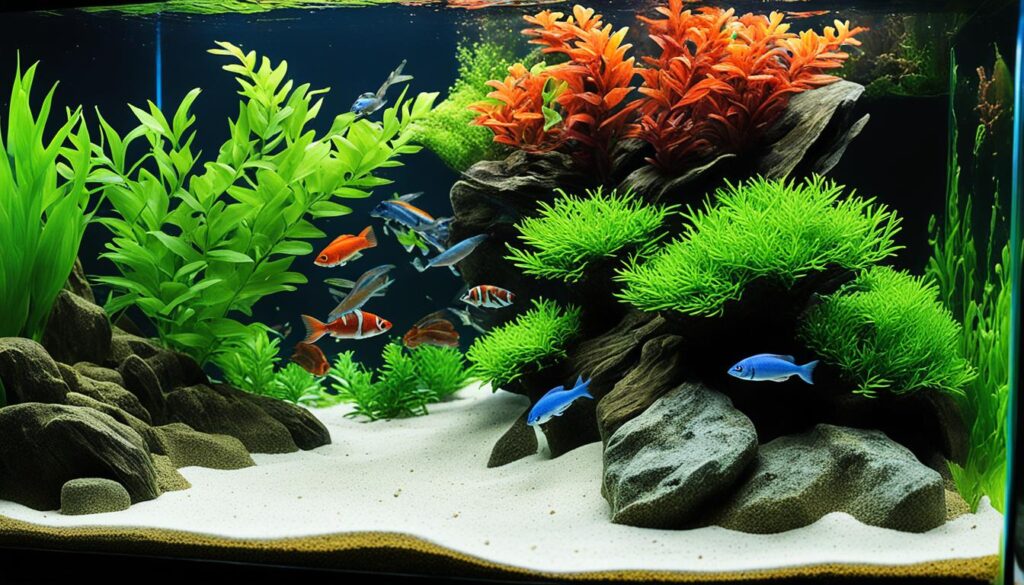
Overall, sand substrate offers a host of advantages, from its ability to replicate natural aquatic environments to its ease of cleaning. With a wide range of sand types available, you can select the perfect substrate that both complements your aquarium’s aesthetics and provides a comfortable habitat for your fish and plants.
Soil
When it comes to creating a thriving ecosystem in your freshwater aquarium, using soil as a substrate can provide numerous benefits. Aquarium soil is specially formulated to provide essential nutrients for plant growth and promote a healthy aquatic environment.
One of the key advantages of using soil as a substrate is its ability to support the growth of aquatic plants. The rich nutrient content in aquarium soil helps plants establish strong root systems, leading to vibrant foliage and improved oxygenation within the tank. This is especially beneficial for planted tanks, as the plants can extract nutrients directly from the soil, promoting optimal growth.
There are different types of soil available for aquariums, each with its own unique properties. Some popular options include:
- Clay-based soil: Ideal for plant growth due to its high nutrient content and water retention capabilities.
- Mineralized soil: Enriched with essential nutrients like iron, potassium, and phosphorus to foster healthy plant growth.
- Substrate additives: These specialized products can be mixed with regular aquarium soil to enhance its nutrient content and promote optimal plant growth.
To maintain a healthy soil substrate in your aquarium, regular maintenance is essential. Here are a few tips:
- Ensure proper water circulation to prevent the formation of anaerobic areas within the soil.
- Monitor water parameters and adjust as necessary to maintain optimal conditions for plant growth.
- Regularly trim and prune plants to prevent overcrowding and maintain a balanced ecosystem.
- Vacuum the substrate periodically to remove any accumulated debris or excess organic matter.
Overall, using soil as a substrate offers a natural and nutrient-rich environment for your freshwater aquarium. By selecting the right soil type and implementing proper maintenance practices, you can create a thriving aquatic ecosystem that promotes healthy plant growth and provides a visually pleasing display for your enjoyment.
Incorporating soil as a substrate in my freshwater aquarium has been a game-changer for the overall health and appearance of my tank. With its nutrient-rich composition, my plants are flourishing, creating a vibrant and natural underwater landscape.
| Benefits of Soil as a Substrate | |
|---|---|
| Benefit | Description |
| Promotes plant growth | Aquarium soil provides essential nutrients for strong root development and vibrant foliage. |
| Natural aesthetics | The earthy brown color of aquarium soil creates a visually appealing and natural-looking substrate. |
| Healthy aquatic environment | Soil helps maintain water chemistry and supports a balanced ecosystem. |
| Enhances oxygenation | The root systems of plants in soil substrates help increase oxygen levels in the tank. |
Aragonite
In the world of freshwater aquarium substrates, aragonite is a popular choice among aquarists. This type of sand is composed of calcium carbonate, which slowly releases into the water, contributing to the maintenance of stable pH levels in the tank. Aragonite is commonly used in reef aquariums due to its ability to create a suitable environment for coral growth. However, it can also be utilized in freshwater tanks for fish species that prefer higher pH levels.
The benefits of using aragonite as a substrate extend beyond pH regulation. Its natural composition provides a visually appealing sandy bed for your aquarium, mimicking the natural habitats of certain fish species. The fine texture of aragonite allows fish to exhibit their natural behaviors, such as digging and sifting through the substrate.
It’s important to note that aragonite is not typically used as the sole substrate in a freshwater aquarium. Instead, it can be mixed with other substrates to achieve the desired pH levels for specific fish species. By blending aragonite with gravel or other substrates, aquarists can create a balanced environment that meets the needs of their fish.
Suitable Fish Species for Aragonite Substrate
- African cichlids
- Mollies
- Guppies
- Livebearers
- Endler’s livebearers
- Salt and pepper corydoras
- Certain species of killifish
It’s crucial to research the specific requirements of your chosen fish species before incorporating aragonite into their aquarium. Some fish prefer neutral or acidic pH levels, which may not be suited for aragonite substrates. Additionally, regular water testing is essential to ensure pH stability and create an ideal environment for your fish.
If you’re considering using aragonite in your freshwater aquarium, it’s advisable to seek advice from experienced aquarists or consult with experts at your local aquarium store. They can provide valuable guidance on the proper use and maintenance of aragonite substrates to help you create a thriving aquatic environment for your fish.
Vermiculite
In the world of freshwater aquariums, finding the right substrate for your plants is crucial. One substrate that stands out for its impressive benefits is vermiculite. This unique mixture of minerals offers a range of advantages for aquatic plants, making it an excellent choice for planted tanks.

The Benefits of Using Vermiculite as a Substrate
One of the main benefits of vermiculite is its slow release of potassium and magnesium. These essential nutrients play a vital role in promoting healthy plant growth. By using vermiculite as a substrate in your freshwater aquarium, you can ensure that your plants have a consistent supply of these key elements.
Additionally, vermiculite serves as an excellent anchoring material for plant roots. Its composition provides a sturdy foundation for your plants, allowing them to establish strong root systems. This leads to improved nutrient uptake and overall plant health.
When combined with other substrates like gravel or sand, vermiculite offers a perfect blend of materials for aquatic plants. The combination provides a balanced environment that meets the specific needs of your plants, resulting in vibrant growth and lush greenery in your tank.
Combining Vermiculite with Other Substrates
To maximize the benefits of vermiculite, it’s recommended to combine it with other substrates. By layering vermiculite with materials like gravel or sand, you can create an appealing aesthetic while providing the necessary nutrients for your plants.
Expert Tip: Consider using a layer of gravel or sand as the bottom substrate, topped with a layer of vermiculite. This combination offers both stability and nutrient-rich conditions for your aquatic plants.
Not only does this combination support plant growth, but it also enhances the overall look of your aquarium. The contrasting textures and colors create visual interest, making your tank a stunning centerpiece in any room.
Peat Moss
When it comes to creating a healthy and thriving environment for your freshwater aquarium, choosing the right substrate is crucial. One option that aquarium enthusiasts often turn to is peat moss. This versatile material offers several benefits for both your fish and plants, making it a popular choice among aquarists.
Using peat moss as a substrate provides a natural way to buffer and soften water in your aquarium. It acts as a filter material, helping to maintain stable pH levels and create a more conducive environment for certain fish species. Additionally, peat moss is organic and free from fertilizers or chemicals, ensuring the safety and well-being of your aquatic pets.
Before adding peat moss to your aquarium, it’s important to properly prepare and use it. Start by soaking the peat moss in water to remove any impurities and unwanted substances. Rinse it thoroughly to prevent cloudiness in the tank. Once cleaned, you can add the peat moss to the bottom of your aquarium and spread it evenly.
Benefits of using peat moss as a substrate:
- Acts as a natural filter and softens water
- Helps maintain stable pH levels
- Creates a conducive environment for specific fish species
- Organic and free from chemicals
- Enhances the overall health and well-being of your aquarium
Adding peat moss to your freshwater aquarium can be a game-changer, providing numerous benefits for your aquatic pets and plants. Consider incorporating this natural substrate into your tank setup to create a thriving and visually appealing environment for your underwater friends.
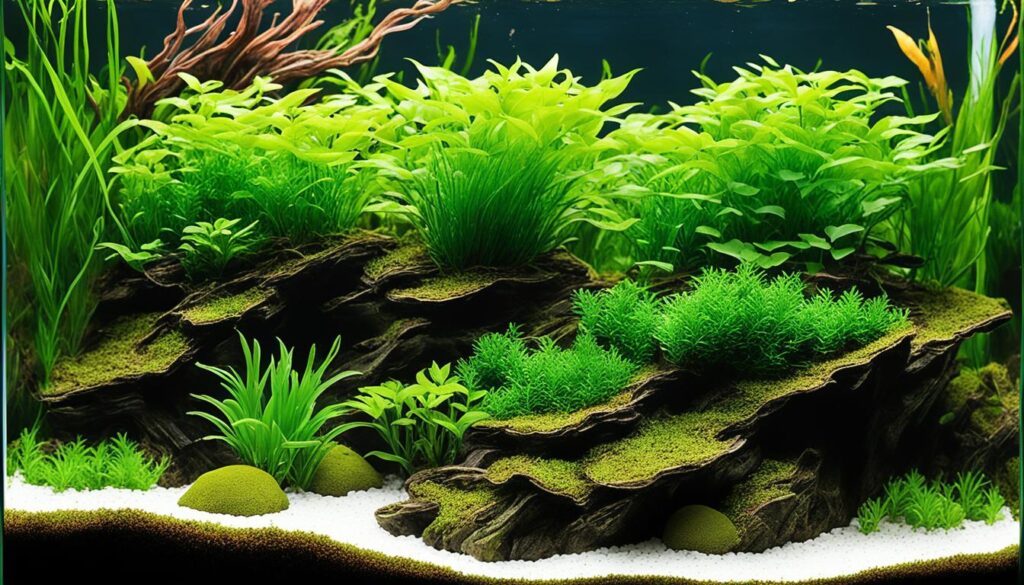
Coral
When it comes to choosing the right substrate for your freshwater aquarium, crushed corals can offer several benefits. Not only are they commonly used in reef aquariums, but they can also be beneficial for certain freshwater fish species, especially those that prefer hard water conditions. One of the key advantages of using coral as a substrate is its ability to help maintain stable pH levels in your aquarium.

Coral is known for its natural buffering properties, which can help regulate and stabilize the pH of the water. This is particularly important for fish that require a specific pH range to thrive. By using coral as a substrate, you can create an environment that closely mimics the natural conditions of these fish, promoting their overall health and well-being.
Certain freshwater fish species that prefer hard and alkaline water can benefit greatly from a coral substrate. Some examples include Malawi cichlids, African rift lake species, and livebearers like guppies and mollies. These fish thrive in water with high mineral content, and the presence of coral in the aquarium can help provide the ideal conditions for them.
It’s also worth noting that crushed corals can be combined with other substrates to create the perfect environment for your fish. For instance, you can mix coral with gravel or sand to achieve the desired aesthetic effect while still reaping the benefits of maintaining stable pH levels.
If you decide to use coral as a substrate in your aquarium, it’s important to monitor the pH levels regularly to ensure they remain within the optimal range for your fish. Additionally, keep in mind that coral can gradually release calcium carbonate into the water, which can contribute to the hardness of the water. Consider the requirements of your fish and adjust the amount of coral accordingly.
Overall, incorporating crushed corals as a substrate in your freshwater aquarium can provide numerous benefits, especially for fish species that prefer hard and alkaline water. Not only can it help maintain stable pH levels, but it can also create a more natural and suitable environment for your fish to thrive.
Marbles
Marbles can be a visually appealing option for aquarium owners looking to create a unique and decorative environment for their freshwater tanks. While not commonly used as a substrate for everyday aquariums, marbles can be utilized for specific purposes, such as breeding tanks or for fish species that enjoy rearranging their tank setup. However, there are considerations to keep in mind before incorporating marbles into your aquarium.
One of the main benefits of using marbles as a substrate is their decorative appeal. They come in various colors, sizes, and patterns, allowing you to create eye-catching designs and patterns in your tank. Marbles can add a vibrant and dynamic element to your aquarium, enhancing its overall aesthetic appeal.
Considerations must be taken into account when using marbles as substrate for freshwater aquariums as their smooth and round surfaces can make it difficult to clean. Fish waste and uneaten food can often become trapped between the marbles, leading to a buildup of debris that can negatively affect water quality if not properly maintained.
“Marbles can add a vibrant and dynamic element to your aquarium, enhancing its overall aesthetic appeal.”
Additionally, marbles may not provide the ideal environment for the growth of aquatic plants. Unlike other substrates such as soil or gravel, marbles do not offer the necessary nutrients or anchoring support for plant roots. Therefore, if your aquarium includes live plants, it’s important to consider alternative substrates that facilitate their growth and ensure their health.
It’s worth noting that marbles can be a suitable option for certain fish species that enjoy digging or rearranging their tank environment. The smooth surfaces of marbles can provide an interesting and stimulating texture for these fish, allowing them to engage in their natural behaviors and exhibit their natural instincts.
In summary, marbles can be utilized as a visually appealing and decorative substrate in freshwater aquariums. While they are not recommended for everyday use due to cleaning difficulties and potential debris buildup, marbles can be used for specific purposes like breeding tanks or for fish species that enjoy rearranging their environment. When considering marbles as a substrate, it’s important to prioritize the well-being of your fish and plants and ensure that their specific needs are met.
| Pros | Cons |
|---|---|
| Enhances aquarium’s visual appeal | Difficult to clean and maintain |
| Suitable for certain fish species that enjoy digging | Not ideal for the growth of aquatic plants |
| Provides a unique and decorative element | Potential for debris buildup and water quality issues |
Using Multiple Layers of Substrates
Creating a natural and visually captivating environment in your freshwater aquarium is easily achievable through the technique of layering substrates. By incorporating different substrates in layers, you not only enhance the aesthetic appeal of your tank but also provide various benefits for your fish and plants.
One of the key benefits of layering substrates is the ability to anchor plant roots effectively. By incorporating a bottom layer of nutrient-rich peat moss or aquarium soil, you provide the ideal foundation for plant growth. This ensures that your aquatic plants receive the necessary nutrients and promote healthy development.
In addition to supporting plant growth, layering substrates also helps in maintaining stable pH levels. By utilizing substrates such as gravel or pebbles in the upper layers, you can effectively control and stabilize the pH levels of your aquarium. This is particularly important for fish species that have specific pH requirements.
Furthermore, the use of multiple substrates creates a more natural environment for your fish, enhancing their overall well-being. You can experiment with combinations of different substrates, such as mixing sand with gravel or incorporating decorative elements, to simulate the appearance of a natural habitat. This not only provides visual interest but also creates a sense of security and comfort for your fish.
FAQ
What is the best color substrate for freshwater aquariums?
The best color substrate for freshwater aquariums varies depending on personal preference and the specific needs of your fish and plants. Gravel, sand, soil, and aragonite are all popular options that come in a variety of colors to enhance the visual appeal of your tank.
What are the benefits of using gravel as a substrate?
Gravel is a versatile substrate choice that comes in a wide range of colors and particle sizes. It is easy to clean and provides a suitable environment for many fish species. However, it’s important to choose gravel with smooth edges to prevent irritation to certain fish with soft skin.
Can I use sand as a substrate for my freshwater aquarium?
Yes, sand is a popular choice for freshwater aquarium substrates. It replicates the natural environment of many aquarium fish and provides a soft and smooth surface for bottom-dwelling species. Sand also does not trap uneaten food or waste, making it easy to clean.
Is soil a suitable substrate for planted tanks?
Yes, soil is a common substrate choice for planted tanks as it provides nutrients for plant growth. It is important to use aquarium soil specifically formulated for underwater use. Soil typically comes in natural brown colors and can be combined with other colorful substrates for visual variety.
How does aragonite affect pH levels in freshwater aquariums?
Aragonite is a type of sand that consists of calcium carbonate. It slowly releases calcium carbonate into the water, helping to maintain stable pH levels. Aragonite is commonly used in reef aquariums but can also be used in freshwater tanks for fish species that prefer higher pH levels.
Can vermiculite benefit aquatic plants in freshwater aquariums?
Yes, vermiculite is a mixture of different minerals that slowly releases potassium and magnesium, making it suitable for aquatic plants. It works best when combined with gravel or other substrates, providing plants with ample material to anchor their roots and nutrients to thrive.
How can peat moss be used as a substrate in freshwater aquariums?
Peat moss can be used as a substrate or filter material to naturally buffer and soften water. It is important to choose organic options without fertilizers or other chemicals that can be toxic to fish. Peat moss needs to be soaked and rinsed before being added to the tank.
What are the benefits of using coral as a substrate in freshwater aquariums?
Crushed corals can help maintain stable pH levels in your aquarium. They are commonly used in reef aquariums but can also be beneficial for certain freshwater fish species, particularly those that prefer hard water. Crushed corals can be combined with other substrates to create the ideal environment for your fish.
Can marbles be used as a substrate in freshwater aquariums?
Marbles can be used as a decorative substrate or for specific purposes like breeding tanks. They are not recommended for everyday aquariums due to the difficulty of cleaning and the potential for trapping fish waste and uneaten food. However, marbles can make attractive decorative pieces and are suitable for certain fish species that enjoy digging or rearranging their tanks.
How can I create a more natural environment for my fish and plants using multiple layers of substrates?
By using different substrates in layers, you can create a more natural environment for your fish and plants while providing visual interest in your tank. The bottom layer can consist of peat moss or aquarium soil for plant growth, followed by a larger grain substrate like gravel or pebbles, and topped with decorations or additional substrates for added visual appeal.
